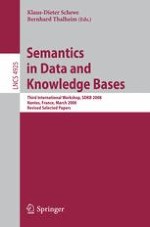This book constitutes the thoroughly refereed post-workshop proceedings of the Third International Workshop on Semantics in Data and Knolwedge Bases, SDKB 2008, held in Nantes, France, on March 29, 2008. The 6 revised full papers presented together with 4 invited papers and a survey on the state of the art in the field, were carefully reviewed and selected for inclusion in the book. The SDKB workshop presented original contributions demonstrating the use of logic, discrete mathematics, combinatorics, domain theory and other mathematical theories of semantics for database and knowledge bases, computational linguistics and semiotics, and information and knowledge-based systems.
